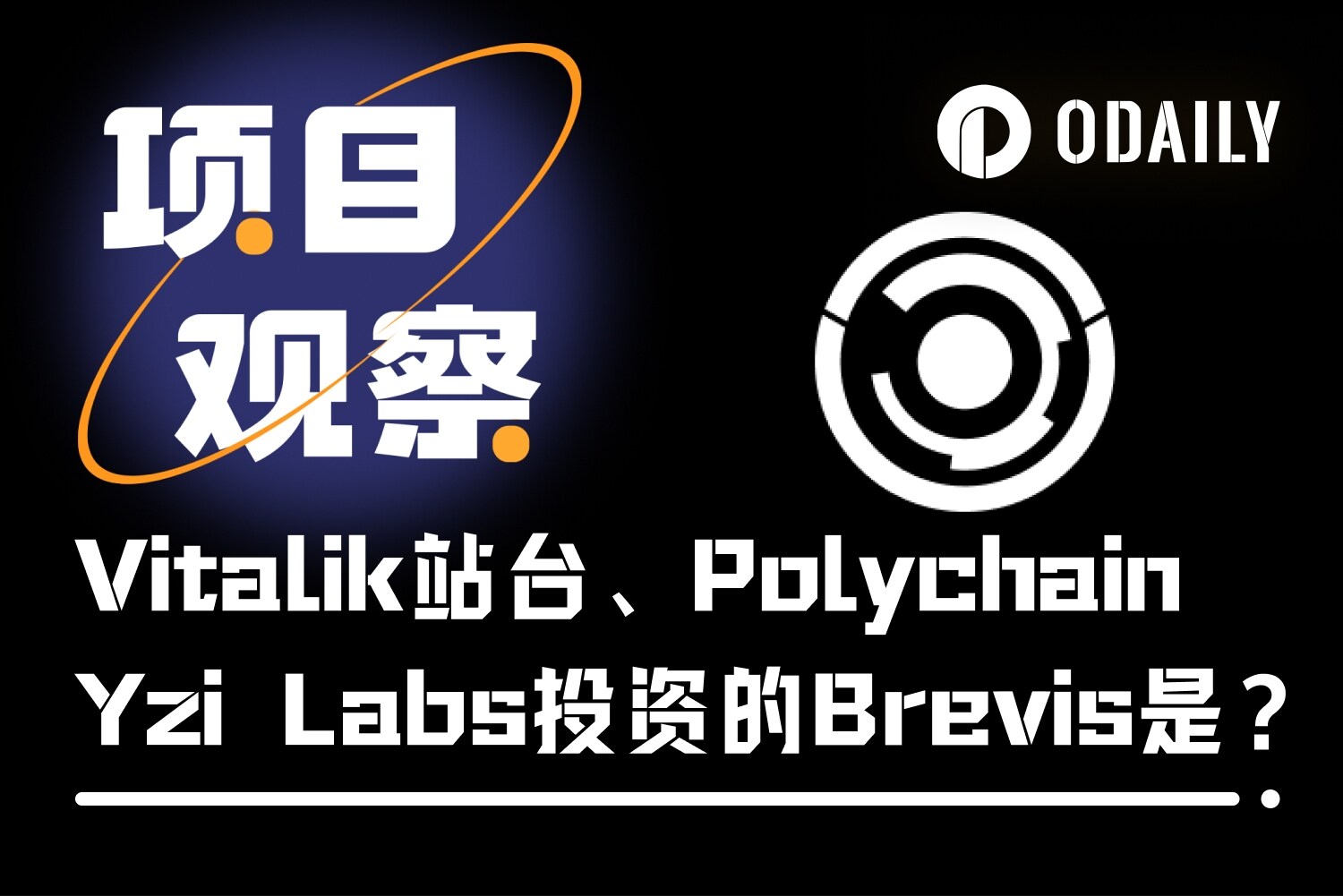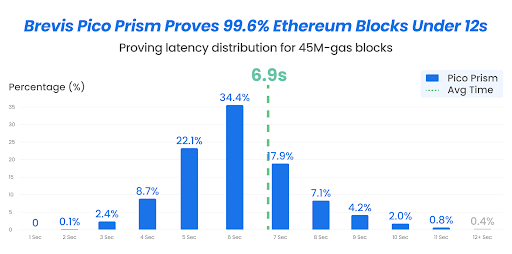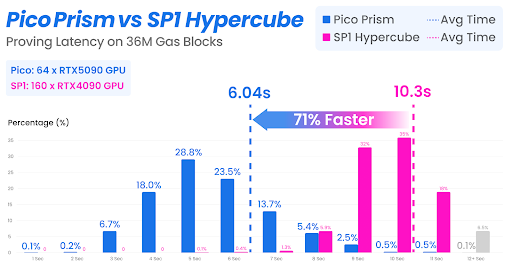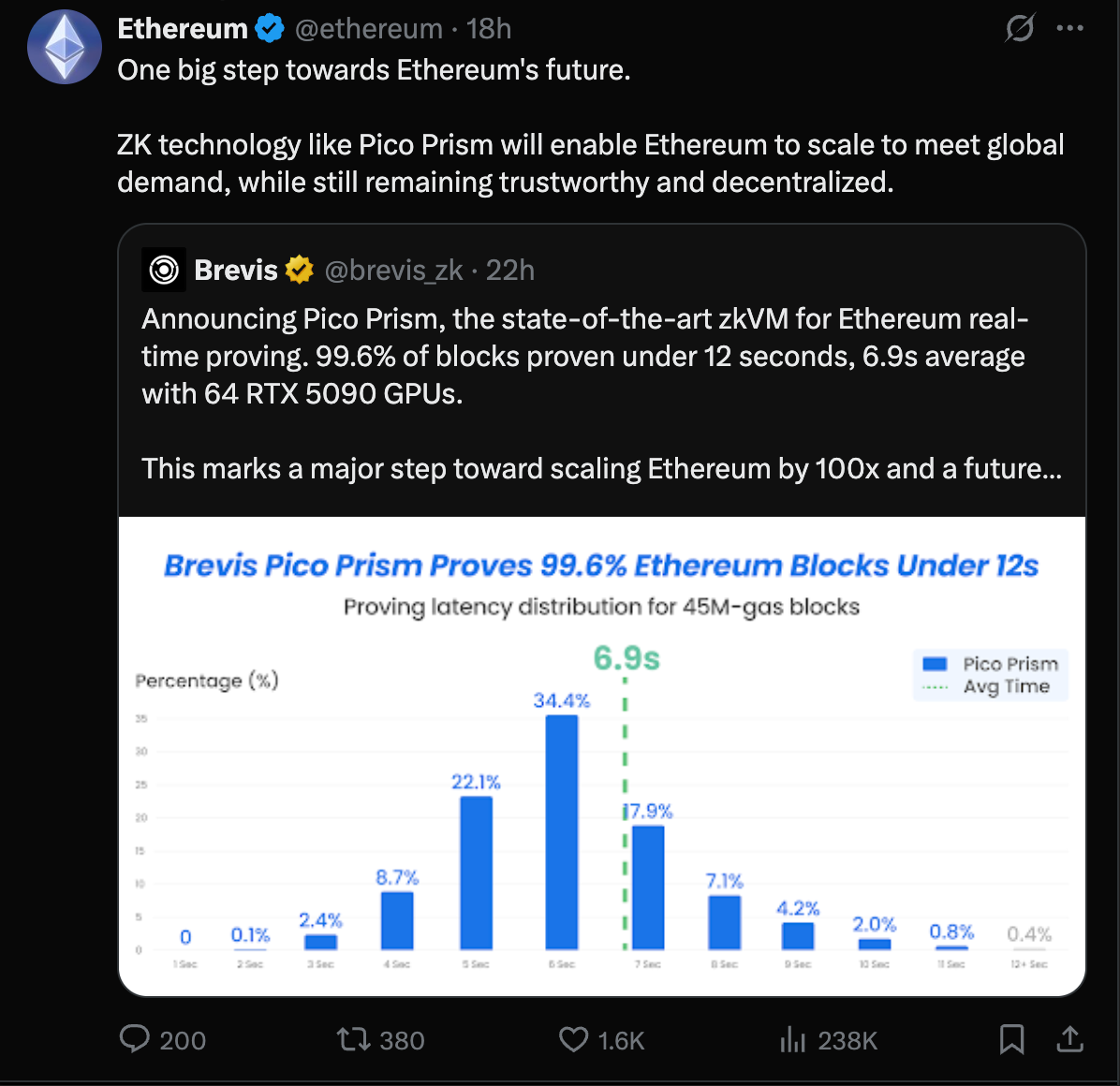Brevis: Vitalik's Favor, $7.5 Million in Funding: How a ZK Coprocessor Unlocks a New Paradigm for Ethereum
Original | Odaily Planet Daily ( @OdailyChina )
By Wenser ( @wenser 2010 )

On October 15th, Vitalik, after a long absence, posted again. This time, he didn't offer his usual philosophical reflections, but rather to promote a favorite project in the ZK space: Brevis, a ZK computation layer. The project secured $7.5 million in seed funding last November, led by Polychain and Yzi Labs (formerly Binance Labs). It also previously launched the Kaito ranking and points program. Odaily Planet Daily will provide a brief overview and analysis of the project in this article for your reference.
Brevis Pico Prism: Ethereum's best hope for x100 scalability?
On October 15, Brevis officially announced the latest progress of the project - the launch of Pico Prism, the most advanced zkVM for real-time proof of Ethereum.
According to the official introduction: "In a cluster equipped with 64 RTX 5090 high-end GPUs, 99.6% of ZK proof tasks can be completed within 12 seconds, with an average of only 6.9 seconds." In the future, "(users) will even be able to) verify the blockchain network through their mobile phones."

This description may still not be direct enough, so let's explain the following three questions step by step: What is Brevis? What is its use? And why did Vitalik support it?
Brevis: A "ZK Coprocessor" featuring the concept of "Infinite Computing Layer"
According to official information, Brevis is a ZK coprocessor network built on zero-knowledge proof, positioned as "the infinite computing layer for Web 3 and everything."
In March 2023, Celer announced the launch of Brevis, a ZK full-chain data computation and verification platform. Brevis enables dApps to access, compute, and utilize arbitrary data across multiple blockchains in a fully trustless manner. Its services cover data-driven DeFi, zkBridge, on-chain user acquisition, zkDID, social account abstraction, and other sectors.
In April 2024, Brevis coChain AVS launched on mainnet . By combining ZK proofs with cryptoeconomic security driven by EigenLayer restaking, coChain aims to significantly reduce costs in ZK coprocessing and enable new features.
In February 2025, Brevis announced the release of Pico, a high-performance, modular, general-purpose zkVM (zero-knowledge virtual machine) . Pico allows developers to use Rust, leveraging a general-purpose zkVM and accessing a highly optimized ZK coprocessor. Developers can choose from a wide range of built-in options or fully customize the proof backend and virtual machine instance to optimize application performance and user experience.
In November 2024, Brevis officially announced its seed funding round, following a $7.5 million funding round in September co-led by Polychain Capital and Binance Labs (now Yzi Labs), with participation from IOSG Ventures, Nomad Capital, Bankless Ventures, Hashkey, and several undisclosed angel investors. Furthermore, according to co-founder Michael Dong Dong, the funding round was a token offering, but the specific valuation was not disclosed.
At that time, Brevis's ZK coprocessor was still in the mainnet test stage, and its partners included Kwenta, JoJo Exchange, Trusta, etc.; DeFi protocols such as PancakeSwap, Frax, Gamma, Quickswap, Mask Network, 0G, Bedrock and Mellow Finance were all building products and functions driven by Brevis.
The value of Brevis: Serving on-chain and off-chain computing, improving system throughput
As for the value of Brevis, in a nutshell, it can help developers run complex calculations (such as data processing, machine learning reasoning, simulation, etc.) off-chain and generate small ZK proofs to quickly verify the results on-chain, thereby realizing trustless scalable applications.
In simple terms, it means finding a balance between traditional on-chain computing, which is secure but has limited computing power (for example, it cannot efficiently process historical data) and off-chain computing, which is powerful but unverifiable (relying on centralized nodes) - using ZK technology to realize off-chain computing data and verify the results on-chain.
More specifically, Brevis's functions as an "intelligent co-processor" include:
- Access on-chain historical data : ZK Data Coprocessor can query and calculate any on-chain history (such as transaction volume, user behavior) and generate ZK proofs.
- Running calculations : Pico zkVM supports writing general programs in Rust, supports ZKML (zero-knowledge machine learning), cross-chain verification, etc.
- Practical applications : enabling DeFi dynamic incentives, RWA transparent rewards, perp DEX loyalty programs, etc.
Simply put, it can make smart contracts "smarter", shifting from passive execution to active computing, saving computing costs and improving computing efficiency, thereby facilitating user interaction with the protocol, asset sedimentation and increasing the adoption rate of the protocol.
The reason why Brevis got Vitalik's support: ZK's charming moment
There are three main reasons why Brevis received Vitalik's support and praise:
1. The effectiveness of Brevis’ technical solution: it is 3.4 times faster than traditional methods and the hardware cost is halved. This directly solves the redundant computing problem of Ethereum node validators and effectively reduces the overall workload.
Second, the technical solution is highly aligned with the Ethereum ecosystem and roadmap : Brevis, as a ZK coprocessor network, allows dApps to access historical on-chain data, run off-chain computations, and generate verifiable proofs. This perfectly aligns with Vitalik's 2025 Ethereum roadmap, which includes 99% coverage, sub-10-second proofs, hardware costs below $100,000, and a home-grade setup (<10 kW power consumption). This will support higher gas limits, lower transaction fees, and more complex DeFi operations (such as PancakeSwap's dynamic fees and Usual's RWA rewards). It will also allow more people to participate in network validation using their mobile phones, promoting L1 ZK-EVM integration and decentralization.
Third, overall ecosystem impact and actual adoption : Brevis has generated over 72.9 million proofs, covering 100 partners such as MetaMask, PancakeSwap, and Frax, and driving $4 billion in TVL growth. It can be said that the emergence and development of Brevis is a real solution for large-scale adoption.

Brevis Interaction Options: Development, Community Tasks
Currently, community users can interact by developing applications or participating in community tasks, without the need for professional ZK knowledge.
Developer :
SDK and Pico zkVM : Build ZK applications (such as dynamic incentives and cross-chain security) using Rust code and a Solidity callback. Integration requires only three steps: specify data, run computations, and verify on-chain. Documentation: https://docs.brevis.network/.
Examples : Earn LP rewards by trading on PancakeSwap Infinity; verify restaking on Kernel DAO; participate in Continuous Profit Incentives (CPI) on Usual Protocol.
Community Mission :
Proving Grounds event : Visit https://proving-grounds.brevis.network/ and connect your wallet (follow @brevis_zk and join Discord).
Phase 1: Basic Training (October 13 - November 2, 2025): Social tasks such as daily check-in (10 Sparks/day, with a bonus of 200 for consecutive check-ins), liking/retweeting posts (100 Sparks + milestone bonus of 500), and inviting friends (200 Sparks/person).
Phase 2: Field Operations (to be launched on November 3): Interact with real dApps on the chain (such as DEX trading, lending) to earn more Sparks points.
Note: 1 wallet corresponds to 1 X account and Discord account, and points will be updated within 24 hours.
Finally, judging from the Ethereum Foundation’s previous publications, Brevis has a promising future.

- 核心观点:Vitalik为ZK协处理器Brevis站台。
- 关键要素:
- 证明任务最快6.9秒完成。
- 硬件成本减半,效率提升3.4倍。
- 已覆盖百个合作伙伴,推动40亿美元TVL。
- 市场影响:推动ZK技术大规模应用。
- 时效性标注:中期影响



